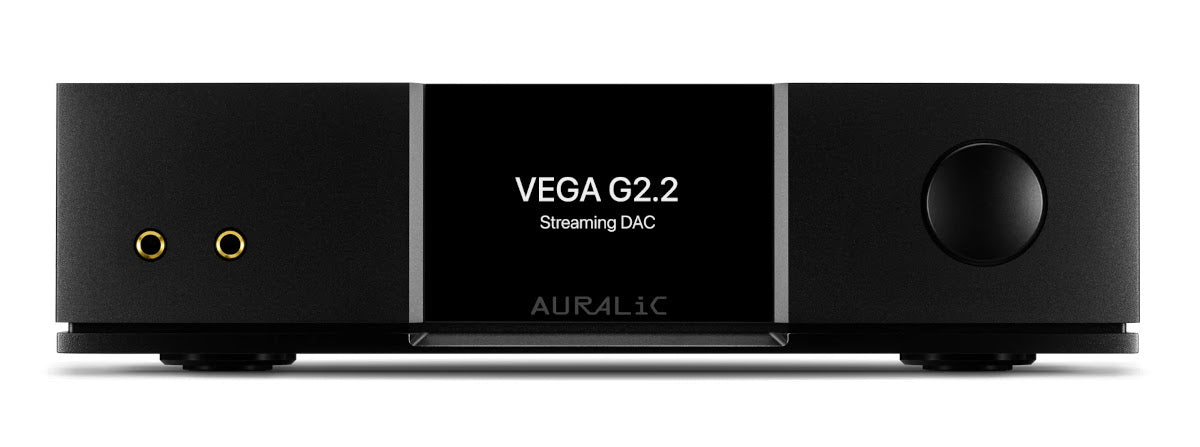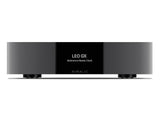
Why the .2? Auralic's products start out so good that only incremental upgrades are possible.
The first thing that will strike you, hopefully not literally, about the Auralic Vega G2.2 is its sheer mass. In an era of butterfly-light electronics, it's a blunt-force surprise to pick up a digital source component and find it weighs 20 lb.
With most of those ultra-light laptops and computers, if you listen carefully, you can hear noise through the headphones or speakers as they work. This article was written on a laptop that produces a faint buzz on the speakers every time the screen is scrolled.
If you can hear noise, it is no longer hi-fi. The loss of air, separation, and microdetail starts long before the noise can be heard. When you listen to a great DAC and realize it is dead silent, it's not as if your old DAC was audibly buzzing or hissing. And yet, you can clearly hear the effect of a lower noise floor simply by how sounds emerge from that proverbial "black background."
This is why the Vega 2.2 is so heavy. Like a knight in double-walled armor, it has a thick aluminum outer chassis and a copper second skin to completely shield its circuits. In this way, digital circuits with their high-frequency switching hash are kept away from analog circuits, which are, in turn, kept insulated from externally induced noise (most commonly by gigahertz cell and data transmissions), and all of these circuits are kept away from the main power supplies with their big-boy currents and correspondingly outsize interference.
This shielding also protects signals in nearby components, especially the delicate pre-phonostage analog chain. We have had so many customers with unexplained buzzing from their turntable that is traced to a Wi-Fi router. In one particularly baffling case, it turned out to be the Wi-Fi router in the next room, just on the other side of the wall from the audio system.

Careful Femtoclocking
Our digital nerds predict the next big thing in digital audio is clocks. More companies are making external clocks, and more streamers and streaming DACs come with master clock inputs.
The Vega has an input for Auralic's Leo clock, and while this is a huge upgrade sonically, not everyone can justify the Leo's $10,000 price tag. Worry not; we are confident there will be more options as this product segment gets more competitive.
Even without an external unit, the Vega's clocking is highly optimized. It uses Auralic's Direct Data Recording, which writes the audio data directly into system memory in binary (less processing), which is fed to the DAC while being held in tight lockstep by a femtoclock.
Michael Evans recently reviewed the Vega G2.2 on Stereonet UK. He found set up very easy: The Vega was immediately recognized by Roon, and it streamed from his NAS with no issues. Michael has found other streamers to be "a little cold and unemotional" but not the Vega, even though its level of detail seemed to "grant access to each different effect" while listening to Kraftwerk.
Michael notes that while the Vega G2.2 "faces stiff competition from some rivals that also excel sonically, this product's competence as an all-round package is hard to beat."
|
AURALiC VEGA G2.2 Streaming DAC $7,899.00 |
The Clocks Strike Back
The Vega G2.2's internal clock is rated to an accuracy of 60 femtoseconds. One femtosecond is one millionth of one billionth of a second, which is how long light takes to travel the length of a virus. Is this level of accuracy even needed in audio?
A couple of weeks ago, we wrote about how having a speaker that's linear to 60 kHz has nothing to do with whether we can hear at those frequencies. Instead, a speaker that's accurate to such a high frequency will be far more accurate in the audible band than a speaker that has rolled off by 20 kHz. It also means that all harmonic perturbations are kept far away from the critical 20 Hz to 20 kHz range.
Similarly, in digital clocking, when you start with a clock that is accurate at a microscopic scale, and you magnify, divide, or otherwise burden this system, its accuracy at perceptible levels is so much greater. This is why clocks are becoming more a part of the discussion. As digital clock accuracy gets ever better (i.e., into insane femto-territory), listeners find that audio gets correspondingly better. Humans are unbelievably sensitive to timing errors in music.
If you have an Auralic streamer or streaming DAC, you should seriously consider adding the Leo GX clock for a profound improvement in sound.
|
AURALiC LEO GX Premium Reference Master Clock $10,499.00 |
New Video: The Ultimate Sonos Killer
Upscale Audio's Kevin Deal and Jordan Perez discuss Kevin's CRAZY home experiment and then dive into why the Cabasse Abyss is a 'just add speakers' hi-fi product that Kevin calls a "$1,795 miracle".


